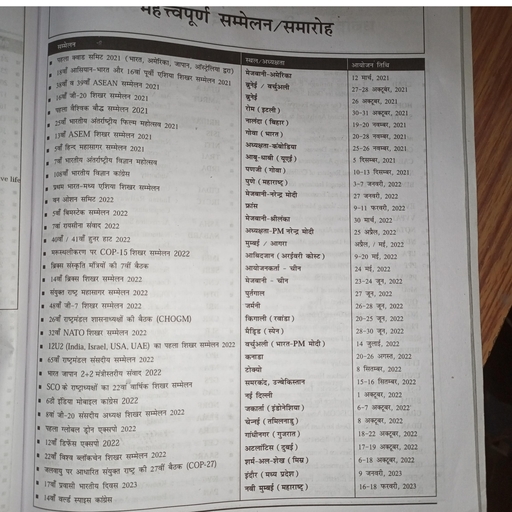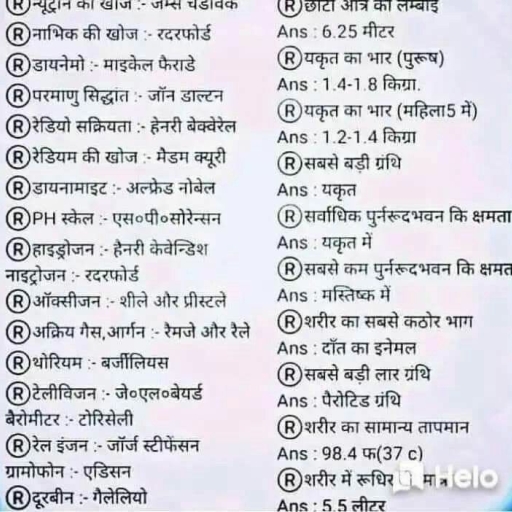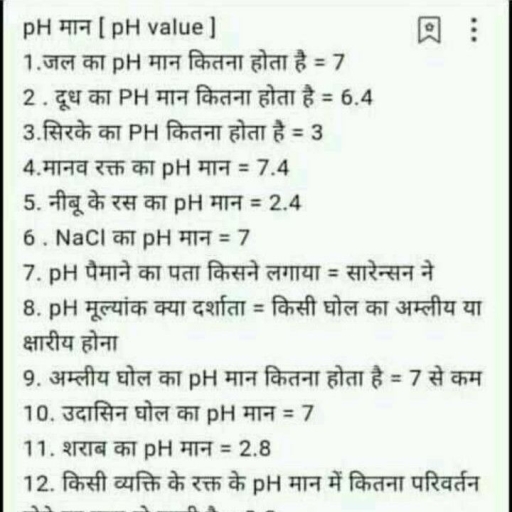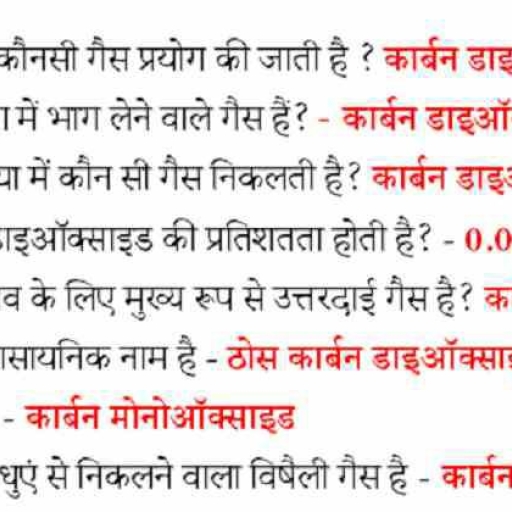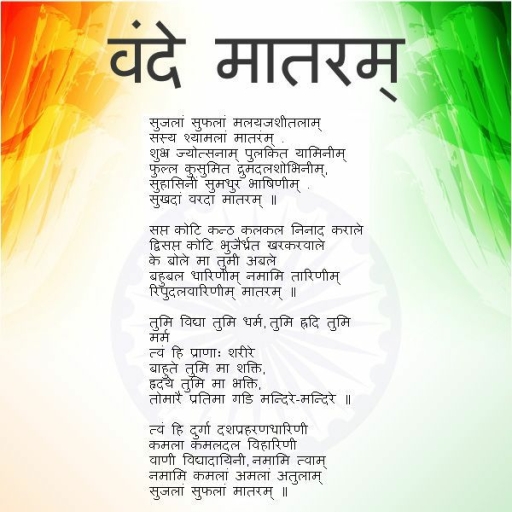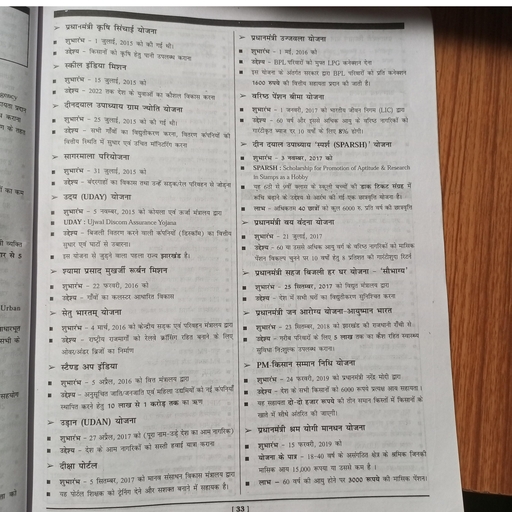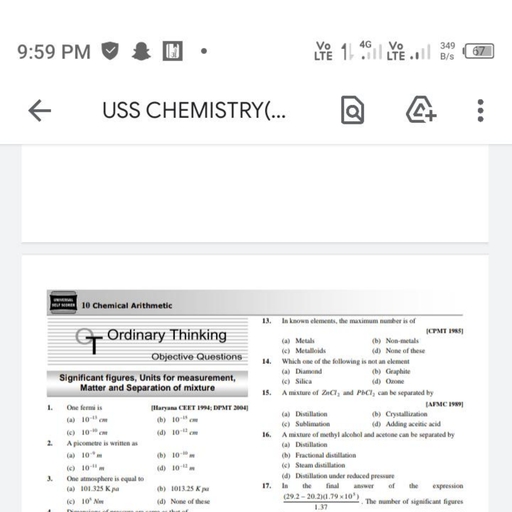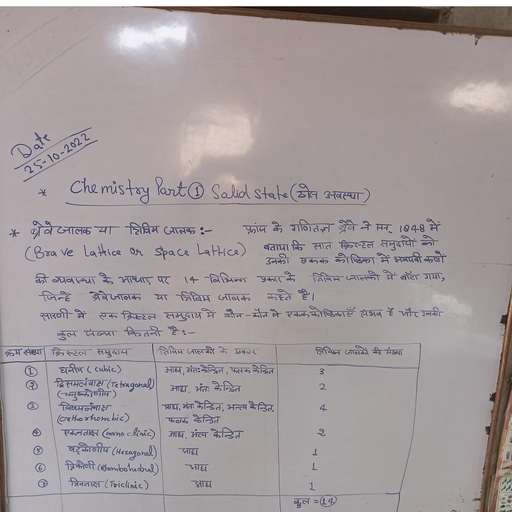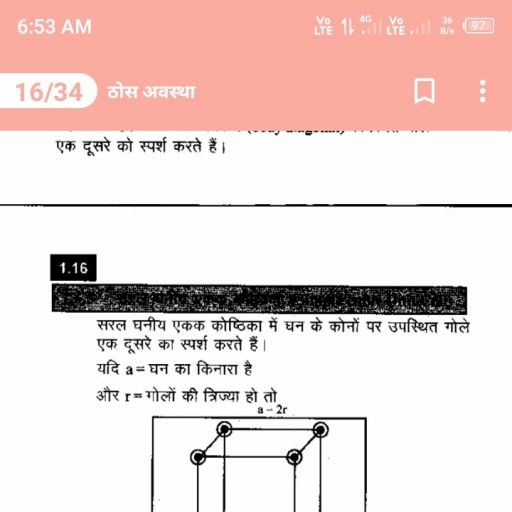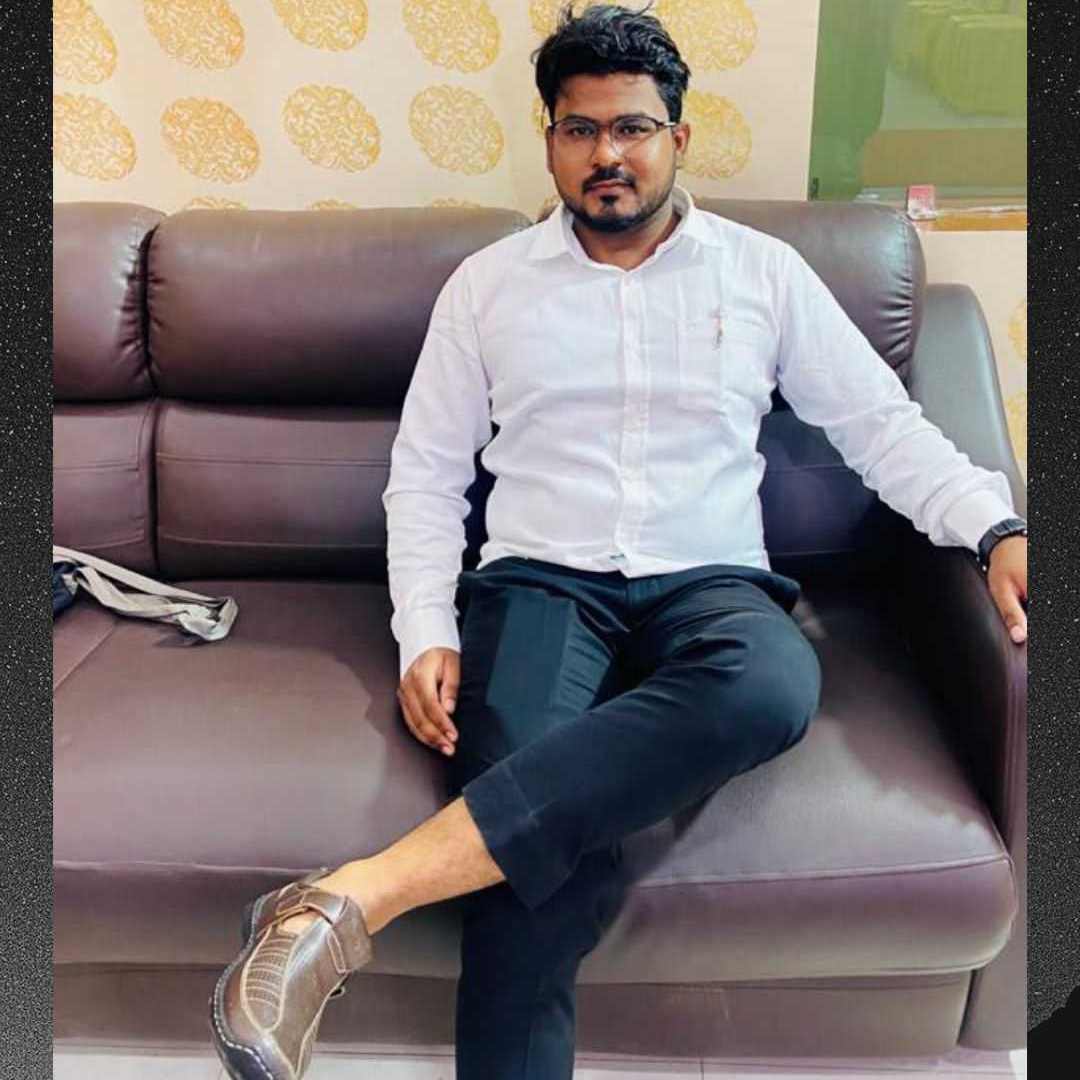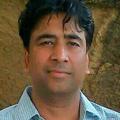Question 1 :
A plane glass plate is placed over a various coloured letters (violet, green, yellow, red). The letter which appears to raised more
Question 2 :
In order to get a diminished virtual image, the object can be placed anywhere in front of a :
Question 3 :
A ray of light travels from air to glass at an angle of incidence of $37^{\circ}$, the angle of refraction is $24^{\circ}$. What is the refractive index of glass?<br/>(Given: $\sin 37^{\circ} = 0.60, \sin 24^{\circ} = 0.40)$
Question 4 :
If a $3cm$ tall object placed perpendicular to principal axis of a convex lens of focal length $15cm$ produces a real invented image of height $15cm$, then its object distance $(u)$ is ................ and image distance $(v)$ is ................
Question 7 :
If $f$ is the focal length of a lens, then the power of the lens is equal to
Question 8 :
Four students perform an experiment on tracing the path of a ray of light passing through a rectangular glass slab. Their individual observations are:<br>identify the incorrect observation and correct them.<br>
Question 9 :
If $f$ is focal length of the lens in $cm$, then the power of a lens is equal to:
Question 10 :
Due to refraction, sunrise appears ______ sun comes to horizon and sunset appears______sun leaves horizon respectively.
Question 11 :
Which of the following is not a use of concave lens?
Question 12 :
A wave has velocity v in medium P and velocity 2v in medium Q. If the wave is incident in medium P at an angle of 30, then the angle of refraction will be
Question 13 :
A concave mirror of focal length $f$ (in air) is immersed in water $(\mu=4/3).$ The focal length of the mirror in water will be
Question 14 :
The power of a lens whose focal length is one metre is ______ dioptre.
Question 17 :
A student obtained a sharp inverted image of a distant tree on a screen placed in front of the concave mirror. He then removed the screen and tried to look into the mirror. He would now see:
Question 18 :
Where should the object be placed in front of a concave mirror so that the image formed is of the same size as the object?
Question 19 :
"Value of refractive index remains same for light rays with different wavelength and for a particular material"
Question 20 :
What is the size of image when position of object is at F, position of image is at infinity and image formed through concave mirror?<br>
Question 22 :
State whether true or false : The degree of convergence of divergence of light rays achieved by a lens is expressed in terms of its power.
Question 23 :
A real, inverted and equal in size image is formed by
Question 24 :
A spherical mirror and a thin spherical lens have each a focal length of $-15$ cm. The mirror and lens are likely to be :<br/>
Question 25 :
A beam of light passing from air enters into the glass. Identify which of the following statements is true?<br/>
Question 26 :
The incident ray, the _______ ray and the normal lie in the same plane during refraction.
Question 30 :
The relation among $u$, $v$ and $f$ for a mirror is:
Question 32 :
State whether true or false:A concave lens forms a magnified or diminished image depending on the distance of object from it.<br/>
Question 36 :
A ray of light incident at the optical centre of lens, passes undeviated after refraction.<br>
Question 40 :
A ray of light is incident perpendicularly on a glass slab. The angle of incidence is :
Question 42 :
The image of an object formed by a device isalways virtual and small. The device may be
Question 43 :
Convex lens are used in eyeglasses to correct which type of defect?<br>
Question 44 :
Ray optics fail when the size of the obstacle is :
Question 45 :
The heat of sun focussed by a convex lens on a piece of paper is capable of
Question 46 :
Identify the phenomenon due to which a converging lens forms an image :
Question 47 :
If in a plano-convex lens, the radius of curvature of the convex surface is 10 cm and the focal length of the lens is 30 cm, then the refractive index of the material of lens will be
Question 48 :
A ray of light passing through the focus of a concave mirror will be :
Question 49 :
No matter how far you stand from a mirror, your image appears erect. The mirror is likely to be<br>
Question 51 :
Light ray that strikes surface of a glass slab normally. Will it deviate from its path? Yes or No<br/>
Question 53 :
Sometimes blurred and less sharply defined images are formed. This defect is called
Question 55 :
When light passes from one medium to another, the physical quantity that remains unchanged is
Question 56 :
Two convex lens of focal lengths ${f}_{1}$ and ${f}_{2}$ form images with magnification ${m}_{1}$ and ${m}_{2}$, when used individually for an object kept at the same distance from the lenses. Then ${ f }_{ 1 }/{ f }_{ 2 }$
Question 57 :
An object is placed at a distance of 1.5 m from a screen and a convex lens is interposed between them. The magnification produced is 4. The focal length of the lens is then
Question 58 :
Magnification produced by spherical lens is $+2.5$. What is the nature of image?
Question 59 :
For the same statement as above, the ratio of the two image sizes for these two positions of the lens is<br>
Question 63 :
The power of a lens is a measure of its degree of
Question 65 :
A beam of monochromatic blue light of wavelength $4200\mathring { A } $ in air travels in water of refractive index ${ 4 }/{ 3 }$. Its wavelength in water will be
Question 66 :
If an object is placed at a distance of 20cm from the pole of a concave mirror, the magnification of its real image is 3. If the object is moved away from the mirror by 10cm, then the magnification is -1.
Question 67 :
A ray of light in a liquid of refractive index $1.4$ approaches the boundary surface between the liquid and air at an angle of incidence whose sine is $0.8$. Which of the following statement is correct about the behaviour of the light?
Question 68 :
The far point of a myopia eye is $1.5 m$. To correct this defect of the eye, the power of lens is _______.
Question 69 :
Rays of light fall on a glass plate of refractive index $=\sqrt{3}$. If the angle between refracted ray and reflected ray is $90$, the angle of incidence is :
Question 70 :
A concave mirror produces $10$ times enlarged image (real) of an object placed $1 cm$ in front of it. Where is the image located?
Question 71 :
A diverging meniscus lens has a focal length of -20 cm. If the lens is held 10 cm from the object, the magnification is :
Question 72 :
A film projector magnifies a $\displaystyle 100\ { cm }^{ 2 }$ film strip on a screen. If the linear magnification is $4$, the area of the magnified film on the screen is be $\displaystyle 1000\ { cm }^{ 2 }$
Question 74 :
The radius of curvature of a plano-convex lens  is 20 cm If the refractive index of the material of the lens be 1.5 it will
Question 75 :
A ray of light travels from ethanol into air. If the angle of incidence of the ray at the boundary is $30^0$ and the refractive index of ethanol is 1.36, what is the angle of refraction of the ray as it emerges out of ethanol?
Question 77 :
When light passes from air to glass, it experiences a change of:
Question 78 :
An object 20 cm from a concave mirror form an image, double the size of the object, on a screen. How far should the screen be placed from the mirror? 
Question 79 :
You are given water, mustard oil, glycerine and kerosene. In whichof these media a ray of light incident obliquely at same angle wouldbend the most ?<br>
Question 80 :
An object placed at a distance of <b>16 cm</b> from first principal focus of convex lens, produces a real image at a distance of <b>36 cm </b>from its second principal focus. Then the focal length of the lens is :
Question 81 :
An object is kept at 15 cm from a convex mirror of focal length 25 cm. What is the magnification?<br/>
Question 82 :
Why does light bends while travelling from one medium to another?<br>
Question 83 :
The refractive index of water with respect to air is1.33. The refractive index of air with respect towater will be
Question 84 :
Two thin lenses, when in contact, produce a combination of power$+10D$. When they are $0.25m$ apart, the power reduces to $+6D$. The focal lengths of the lenses (in m) are
Question 85 :
A beam of light passes through a sheet of plastic and out into the air. The beam makes ${\theta}_{1}$ angles with the normal as it passes through the plastic and the angle the beam of light makes with the normal as it passes into the air is ${\theta}_{2}$. The refractive index for air is $1$ and The refractive index for plastic is $2$.<br/>Calculate the value of $\sin{{\theta}_{2}}$, in terms of ${\theta}_{1}$?
Question 86 :
The magnification of the image when an object is placed at a distance x from the principle focus of a mirror of focal length f is?
Question 87 :
A light of wavelength $6000A^{\circ}$ in air, enters a medium with refractive index $1.5$. Inside the medium its frequency is _________ $Hz$ and its wavelength is ______ $6000 A^{\circ}$.
Question 89 :
A light ray travels from optically denser medium to optically rarer medium, if the angle of incidence and refraction at point of incidence are $\angle i$ and $\angle r$ respectively, then find the angle of deviation in terms of $\angle i$ and $\angle r$.
Question 90 :
Assertion: Light waves have different refractive indices in different media.
Reason: Variations in the velocities of light in different media cause the refractive indices to be different.
Question 91 :
A double convex lens of glass of $\mu_1.5$ has radius of curvature of each of its surface is $0.2\ m$. The power of the lens is
Question 92 :
A ray of light coming parallel to the principal axis after passing through a convex lens, passes through its
Question 93 :
An object is at 0.08 m from a magnifying lens and the image is formed 40 cm from the lens. The magnification produced is 
Question 94 :
If the refractive index of water and glass with respect to air are, respectively, $\displaystyle \frac {4}{3}$ and$\displaystyle \frac {3}{2}$then what will be the refractive index of glasswith respect to water?
Question 95 :
The flat face of a plano-convex lens of focal length $10$cm is silvered. A point source placed $30$cm in front of the curved surface will produce a.
Question 96 :
An object is placed on the principal axis of a concave mirror at a distance of 60 cm. If the focal length of the concave mirror is 40 cm then the magnification obtained is equal to:
Question 97 :
A ray of light travelling in air is incident on the plane of a transparent medium. The angle of incident is 45$^o$ and that of refraction is 30$^o$. Find the index of the medium.
Question 98 :
Two power of a converging lens is 4 D and that of a diverging lens is 2.5D.The power of this combination of lenses placed closed together is:
Question 99 :
$0.04m$ of glass contains the same number of waves as $0.05m$ of water, when monochromatic light passes through them normally. Refractive index of water is $4/3$. Refractive index of glass is
Question 100 :
Refractive indices of water and glass are 4/3 and 3/2 respectively. A ray of light travelling in water is incident on the water-glass interface at $30^0$. Calculate the sine of angle of refraction.
Question 101 :
Image of an object at infinity is formed by a convex lens of focal length $30 \ cm$ such that the size of the image is $2 \ cm$. If a concave lens of focal length $20\  cm$ is placed in between the convex lens and the image, at a distance $26\  cm$ from the convex lens, size of the new image is:
Question 102 :
A flim projector magnifies a flim of area $100 $ square centimeter on screen. If linear magnification is $4$ then area of magnified image on screen will be-
Question 103 :
The final image in an astronomical telescope is _______ the original object . Fill in the gap.<br/>
Question 104 :
Two thin lenses of power $+3.5D, -2D$ are placed in contact. Find the power of lens combination.
Question 105 :
The reflecting surface is given by $y = \dfrac{10L}{\pi} \sin \dfrac{\pi x}{5L}$. The co-ordinates of the point where a horizontal ray becomes vertical after reflection is:
Question 106 :
A point object is placed on the principal axis of the convex lens of focal length 20cm at a distance 40 cm to the left on it. The diameter of the lens is 10cm. If the eye is placed 60cm to the right of the lens at a distance h below the principal axis, then max value of 'h' to see the image is
Question 107 :
The distance between an object and its doubly magnified image by a concave mirror is: [ Assume $f$ = focal length]
Question 108 :
In the table below, column I lists various mirrors  and lenses and column II their uses, qualities or properties.<br/><table class="wysiwyg-table"><tbody><tr><td>column  I</td><td>Column II</td></tr><tr><td>I. Plane mirror</td><td>A. Feels thinner in the middle.</td></tr><tr><td>II. Concave mirror</td><td>B. Always forms virtual image.</td></tr><tr><td>III. Convex mirror</td><td>C. Always forms virtual image of smaller size.</td></tr><tr><td>IV. Concave lens </td><td>D. Is used by dentists to examine teeth.</td></tr><tr><td>V. Convex lens</td><td>E. Can be used as reading glass.<br/></td></tr></tbody></table>The correct matching is:
Question 109 :
A symmetric double convex lens is cut in two equal parts by a plane containing the principal axis. If the power of the original lens was 4 D, the power of a divided lens will be
Question 110 :
The angle between the incident ray and the normal is called ________.<br>
Question 111 :
A small object of linear dimension $x$ lies on the axis of an optical mirror of local length $f$ at a distance $a$ from mirror. The linear dimension of image:
Question 112 :
An object is placed at $30$ cm distance from a concave mirror of focal length $20$ cm, then nature, magnification of the image will be:
Question 113 :
A $2.5$ dioptre lens forms a virtual image which is $4$ times the object placed perpendicularly on the lens. Then the required distance of the object from the lens is .
Question 114 :
A short linear object of length $b$ lies along the axis of a concave mirror of focal length $f$ at a distance u from the pole of the mirror. The size of the image is approximately equal to :<br>
Question 115 :
In vacuum, to travel distance 'd', light takes time 't' and in medium to travel distance $'5d'$, it takes time 'T'. The critical angle of the medium is.<br>
Question 116 :
The diameter of the reflecting surface of spherical mirror is called ..............
Question 117 :
When a light of wavelength $4000$ $\displaystyle \overset { \circ  }{ A } $ in vacuum travels through the same thickness in diamond and water separately, the difference in the number of waves is $200$. Find the thickness, if refractive indices of diamond and water are $\displaystyle \frac { 5 }{ 2 } $ and $\displaystyle \frac { 4 }{ 3 } $ respectively.
Question 118 :
A $4.5 cm$ needle is placed $12 cm$ away from a convex mirror of focal length $15 cm$. Find the location of the image and the magnification.
Question 119 :
Air has refractive index $1.0003$. Find the thickness of air column which will contain one more wavelength of yellow light of $6000$ $A^0$ than in same thickness of vacuum.
Question 120 :
A concave shaving mirror has a radius of curvature of 35.0 cm. It is positioned so that the (upright) image of a mans face is 2.50 times the size of the face. How far is the mirror from the face?
Question 121 :
Three convex lenses are available having focal lengths of $4 cm, 40 cm$ and $4 m$ respectively. Which one could be used as magnifying glass?
Question 122 :
A spherical convex surface separates object and image space of refractive index $1$ and $4/3$ respectively. If radius of curvature of the surface s $0.1\ m$, its power is
Question 123 :
An image of a bright square is obtained on a screen with the aid of a convergent lens. The distance between the square and the lens is $40\ cm$. The area of the image is nine times larger than that of the square. Select the correct statement(s).
Question 124 :
A short linear object of length $b$ lies along the axis of a concave mirror of focal length $f$ at a distance $u$ from the pole of the mirror. The size of the image is approximately equal to:<br/>
Question 125 :
The focal length of a thin biconvex lens is 20 cm. when an object is moved from a distance of 25 cm in front of it to 50 cm, the magnification of its image changes from $m_{25}$ to $m_{50}$. The ratio of $m_{25}$ to $m_{50}$ is :
Question 126 :
A ray of light going towards the centre of curvature of a convex mirror ............
Question 127 :
Aconvex lens of radii of curvature 20 cm and 30 cm respectively. It is silveredat the surface which has smaller radius of curvature. Then it will behave as $(\mu_g\, = \, 1.5)$
Question 128 :
A water film is formed on a glass-block. A light ray is incident on water film from air at an angle of$\displaystyle { 60 }^{ \circ }$ with the normal. The angle of incidence on glass slab is<br>($\displaystyle { \mu }_{ g } = 1.5,{ \mu }_{ w } = \frac { 4 }{ 3 }$)
Question 129 :
The glancing angle of incidence is $10^{\circ}$. What will be the glancing angle of reflection?
Question 130 :
The image obtained while finding the focal length of convex lens is...................
Question 131 :
What happens when a ray of light is made to fall on a mirror along the normal?<br/>
Question 132 :
The magnitude of focal length of a concave mirror is $f$. An object is placed at a distance $x$ from the focus and forms a real image. The magnification is:<br/>
Question 133 :
Let the x-z plane be the boundary between two transparent media. Medium $1$ in $z\ge 0$ has a refractive index of $\sqrt { 2 } $ and medium $2$ with $z< 0$ has refractive index of $\sqrt { 3 } $. A ray of light in medium $1$ given by the vector $\vec { A } =6\sqrt { 3 } \hat { i } +8\sqrt { 3 } \hat { j } -10\hat { k } $ is incident on the plane of separation. The angle of refraction in medium $2$ is:









